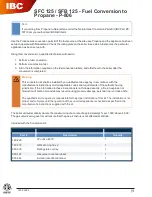
ENGLISH
12
MySMART R.S.I.
13
Table 1
Maximum domestic hot
water fan rotations
Methane
gas (G20)
Liquid gas
(G31)
20 R.S.I.
45
45
rpm
Table 2
Minimum number of fan
rotations
Methane
gas (G20)
Liquid gas
(G31)
20 R.S.I.
12
15
rpm
Table 3
Maximum number of
heating fan rotations
Methane
gas (G20)
Liquid gas
(G31)
20 R.S.I.
45
45
rpm
Table 4
Max CO
2
Methane
gas (G20)
Liquid gas
(G31)
20 R.S.I.
9.0
10.0
%
Table 5
Min CO
2
Methane
gas (G20)
Liquid gas
(G31)
20 R.S.I.
9.0
10.0
%
Table 6
Slow ignition
Methane
gas (G20)
Liquid gas
(G31)
20 R.S.I.
37
37
rpm
4.7
Gas conversion (fig. 43)
It is easy to transform gas from one family to gas belonging to
another family even with the boiler installed.
This job must be done by professionally qualified personnel only.
The boiler is supplied to run on natural gas (G20) – see the product
rating plate for details.
The boiler can be transformed to use propane gas using a special kit.
Follow the instructions given here below for disassembly:
- Switch off the power to the boiler and turn off the gas cock.
- Remove cover connections and shell.
- Lift up and rotate the instrument panel.
- Open the air box cover.
- Disconnect the air pressure switch wires.
- Unscrew the 2 screws (
A
) and remove the bracket and pressure
switch assembly.
- Disconnect the mixer gas ramp (
B
). Unscrew the clamp screws
and relative mixer springs to fan and then remove it (
C
).
- Loosen the plastic Venturi (
C
) by levering from under the teeth (BE
CAREFUL NOT TO FORCE THEM) and press from the opposite
side until it is completely extracted from the aluminium shell.
-
Replace the plastic Venturi with the one contained in the kit.
- Reassemble the mixer with the flap in a horizontal position and
the spacer springs placed at 120° as shown in the figure.
- Reassemble gas ramp working vice versa.
- Refit the bracket and pressure switch assembly on the mixer and
reconnect the air pressure switch wires.
- Switch on the power to the boiler and turn on gas cock again.
- Check the number of times the fan turns.
- Fill in and stick on the accompanying transformation data label.
- Close the air box cover.
- Close up the instrument panel again.
- Reassemble shell and cover connections.
Programme the “Gas type” parameter and regulate the boiler following
the instructions in the “Adjustments” section.
b
Trans
formation must be done by qualified personnel only.
b
After completing transformation, regulate the boiler again
following instructions given in the specific paragraph and
apply the new identification label from the kit.
b
Chec
k that flap and Clapet are working correctly (all open
at rated flow, all closed at minimum flow).
RANGE RATED
This boiler can be adapted to the heating requirements of the system,
in fact it is possible to set the maximum delivery for heating operation
of the boiler itself:
- switch off the power supply
- setting the heating water temperature selector at the maximum value
- remove the shell
- turning the instrument panel towards you
- unscrew the two screws of the small cover on the electronic board to
have access to the terminals
- insert JP1 jumper
- power up the boiler.
The display shows “ADJ” for about 4 sec.: it is then possible to change
the maximum heating value by means of the heating water temperature
selector and the CO button in order to set and confirm the desired
value.
The icon
will appear on the display.
Finish the procedure by removing the jumper JP1 to store the set
values.
Once the desired output (maximum heating) has been set, note the
value on the table on the back cover.
For subsequent controls and adjustments, refer to the set value.
b
The calibration does not entail the ignition of the boiler. By
rotating the heating setpoint selector knob, the value expressed
in hun
dreds (e.g. 25 = 2500 rpm) is automatically displayed.
The boiler is supplied with the adjustments shown in the table.
Depending on plant engineering requirements or regional flue gas
emission limits it is, however, possible to modify this value, referring
to the graph.
800
1200
1600
2000
2400
2800
3200
3600
4000
4400
4800
5200
5600
6000
6400
2
4
6
8
10
12
14
16
18
20
22
24
26
28
30
G
ir
i v
en
til
at
or
e
(r
.p
.m
.)
Portata termica (kW)
Curva portata termica - giri ventilatore
MySMART 20 R.S.I.
HTG curve (Qnheating)
Fan rotations (rpm)
Heat output (kW)
5 -
MAINTENANCE
To ensure product characteristics and efficiency remain intact and
to comply with prescriptions of current regulations, it is necessary to
render the appliance to systematic checks at regular intervals.
When carrying out maintenance work, observe the instructions given
in chapter 1 “Warnings and safety”.
Turn off the appliance before carrying out work or maintenance of
structures near the flue discharge connections and/or fume dis-
charge devices and their accessories. Once work is completed, a
qualified technician must check the efficiency of the appliance.
IMPORTANT:
before undertaking any maintenance or cleaning op-
erations, use the switch of the appliance itself and the system to in-
terrupt the electrical supply and close the gas supply using the tap
on the boiler.
It is also OBLIGATORY
to disconnect the cable connecting the WiFi
Box and the boiler.
-
return power to the boiler
-
int
errupt the vent cycle as described in the section “4.2 Appliance
ignition” on page 9.














































